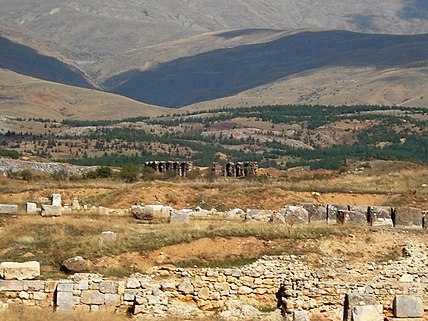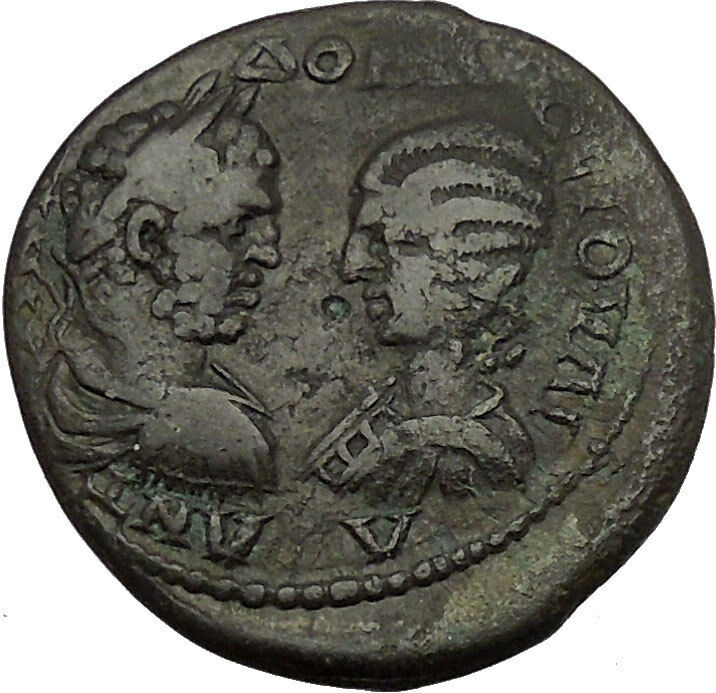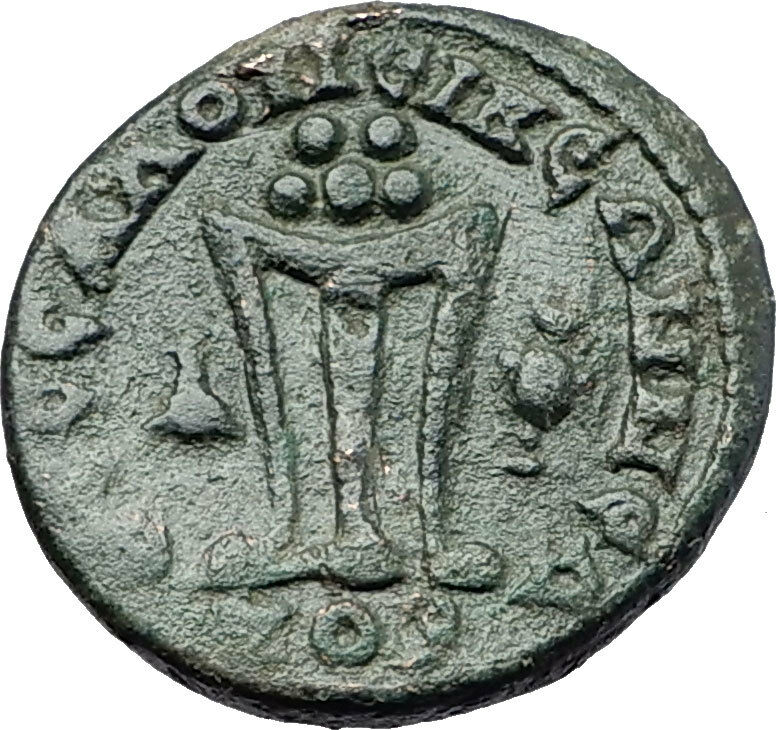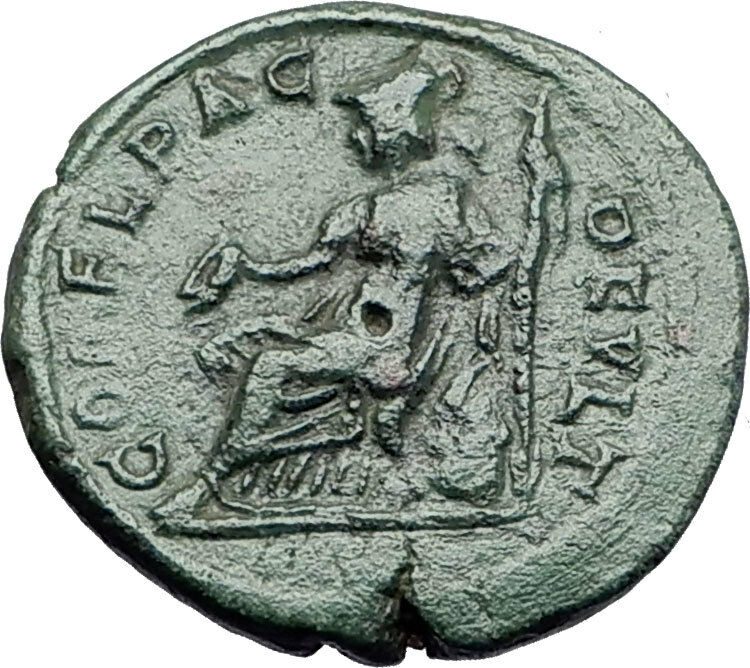|
Volusian – Roman Caesar: 251-253 A.D.
Bronze 25mm (7.80 grams) of the Dacia Province, Dated Year Year 5, 249/250 A.D.
Reference: SNG.Cop:133f; SNG Budapest 103; Pick, AMNG 54
IMP C C VIB VOLVSIANVS AVG, laureate, draped & cuirassed bust right.
PROVINCIA DACIA, Dacia standing left, holding branch and sceptre, emblems of legions V (eagle) and XIII (lion) at her feet to the left and right. AN V in exergue (= year 5 = A.D. 251).
The Era dates from Philip’s victory in his Danubian campaign, A.D. 246. The eagle and the lion represented Roman legions stationed in the province.
You are bidding on the exact item pictured, provided with a Certificate of Authenticity and Lifetime Guarantee of Authenticity.
An aquila, or eagle, was a prominent symbol used in ancient Rome, especially as the standard of a Roman legion. A legionary known as an aquilifer, or eagle-bearer, carried this standard. Each legion carried one eagle.
The eagle was extremely important to the Roman military, beyond merely being a symbol of a legion. A lost standard was considered an extremely grave occurrence, and the Roman military often went to great lengths to both protect a standard and to recover it if lost; for example, see the aftermath of the Battle of the Teutoburg Forest, where the Romans spent decades attempting to recover the lost standards of three legions.
No legionary eagles are known to have survived. However, a number of other Roman eagles, either symbolizing imperial rule or used as funeral emblems, have been discovered.

 Antioch in Pisidia – alternatively Antiochia in Pisidia or Pisidian Antioch and in Roman Empire, Latin: Antiochia Caesareia or Antiochia Caesarea – is a city in the Turkish Lakes Region, which is at the crossroads of the Mediterranean, Aegean and Central Anatolian regions, and formerly on the border of Pisidia and Phrygia, hence also known as Antiochia in Phrygia. The site lies approximately 1 km northeast of Yalvaç, the modern town of Isparta Province. The city is on a hill with its highest point of 1236 m in the north. Antioch in Pisidia – alternatively Antiochia in Pisidia or Pisidian Antioch and in Roman Empire, Latin: Antiochia Caesareia or Antiochia Caesarea – is a city in the Turkish Lakes Region, which is at the crossroads of the Mediterranean, Aegean and Central Anatolian regions, and formerly on the border of Pisidia and Phrygia, hence also known as Antiochia in Phrygia. The site lies approximately 1 km northeast of Yalvaç, the modern town of Isparta Province. The city is on a hill with its highest point of 1236 m in the north.
Roman period
While the Hellenistic Kingdoms (the inheritors of Alexander the Great) were fighting each other and the Galatians, Rome became the most powerful state in Europe and started to follow a policy of expansion to the east. They invaded Macedon, Thrace, and the Dardanelles, and reaching Phrygia via Magnesia and Pisidia. They cowed the Galatians and according to the treaty signed in Apamea in 188 BC, they gave the land of Pisidia which they had got from Antiochos III, to their ally the Pergamon Kingdom which dominated the region. Attalos III, the last king of Pergamon, bequeathed his kingdom to Rome on his death in 133 BC Aristonikos who claimed Pergamon was defeated in 129, then Rome affected Anatolia with its well-developed, creative culture for centuries.
Although Anatolia was dominated by the Roman Empire as the province of Asia, Pisidia was given to the Kingdom of Cappadocia, which was an ally of Rome. During the following years, the authority gap which could not be filled by these kingdoms remote from central government, led to the rise of powerful pirate kingdoms, especially in Cilicia and Pisidia. The Romans were disturbed by these kingdoms and fought against them. Cilicia, Pamphylia, Phrygia and Pisida were freed from pirates and Roman rule was restored in 102 BC.
The geographical and strategical position of the region made it difficult to control the area and maintain constant peace. The Homonadesians, settled in the Taurus Mountains between Attaleia and Ikonion, caused problems for Rome. Marcus Antonius who had to control the roads connecting Pisidia to Pamphylia, charged his allied king Amyntas, King of Pisidia, to fight against Homonadesians, but Amyntas was killed during the struggle.
Then Rome started to colonize using military legions as a solution to the failure of the locally appointed governors. The Province of Galatia was established in 25 BC and Antioch became a part of it. To support the struggle against the Homonadesians logistically, the construction of a road called the Via Sebaste, the centre of which was Antioch, was started by the governor of the Province of Galatia, Cornutus Arrutius Aquila. The Via Sebaste was separated into two and directed to the southwest and southeast to surround the Homonadesians. Secondary connecting roads were built between these two roads. Rome by means of the Via Sebaste P.Sulpicius Quirinius brought an end to the Homonadesians problem in 3 BC, relocating survivors in different surrounding locations.
During the reign of Augustus, eight colonies were established in Pisidia, but only Antioch was honoured with the title of Caesarea and given the right of the Ius Italicum, maybe because of its strategic position. The city became an important Roman colony which rose to the position of a capital city with the name of “Colonia Caesarea“.
Hellenisation became Latinisation during the Roman period and it was applied in Antioch best. The city was divided into seven quarters called “vici” all of which were founded on seven hills like in Rome. The formal language was Latin until the end of the 3rd century. The fertility of the land and the peace brought by Augustus (Pax Romana: Roman Peace) made it easier for the veterans as colonists in the area to have good relations and integration with the natives.
One of the three surviving copies of the Res Gestae Divi Augusti, the famous inscription recording the noble deeds of the Emperor Augustus was found in front of the Augusteum in Antioch. The original was carved on bronze tablets and exhibited in front of the Mausoleum of Augustus in Rome, but unfortunately has not survived. The Antioch copy on stone was written in Latin which is a sign of the importance of the city as a military and cultural base of Rome in Asia. (One of the copies, in Greek and Latin, is in Ankara, the other, in Greek, in Apollonia -Uluborlu).
Gaius Vibius Volusianus (d. August, 253) was a Roman emperor (251 – 253).
He was son to Gaius Vibius Trebonianus Gallus by his wife Afinia Gemina Baebiana. He is known to have had a sister, Vibia Galla.
The death of Decius in early June, 251 led to Trebonianus Gallus’ elevation to the throne. Gallus adopted Decius’ son Hostilian and made him co-ruler. Volusianus was named Caesar and Princeps Juventutis. Later in 251 Hostilian died of the plague and Volusianus replaced him as Augustus and co-ruler.
Father and son were both killed in 253 by mutinous troops in Interamna.
|






 Antioch in Pisidia – alternatively Antiochia in Pisidia or Pisidian Antioch and in Roman Empire, Latin: Antiochia Caesareia or Antiochia Caesarea – is a city in the Turkish Lakes Region, which is at the crossroads of the Mediterranean, Aegean and Central Anatolian regions, and formerly on the border of Pisidia and Phrygia, hence also known as Antiochia in Phrygia. The site lies approximately 1 km northeast of Yalvaç, the modern town of Isparta Province. The city is on a hill with its highest point of 1236 m in the north.
Antioch in Pisidia – alternatively Antiochia in Pisidia or Pisidian Antioch and in Roman Empire, Latin: Antiochia Caesareia or Antiochia Caesarea – is a city in the Turkish Lakes Region, which is at the crossroads of the Mediterranean, Aegean and Central Anatolian regions, and formerly on the border of Pisidia and Phrygia, hence also known as Antiochia in Phrygia. The site lies approximately 1 km northeast of Yalvaç, the modern town of Isparta Province. The city is on a hill with its highest point of 1236 m in the north.




